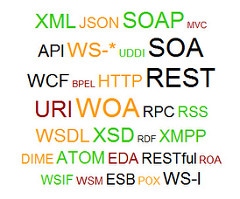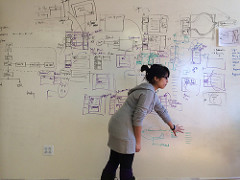Category: Solutions
Don’t forget to lock the front door
Tag and push is not a playground game
Should power users drive the bus?
I admit, machines are smarter than me
There are a variety of ways to look at the auto-classification of files but the ultimate goals would be to make saving a file simple and finding a file reliable. There is no doubt that eliminating the need to tag or add meta data to a file before saving it is a time saver. Its also a time saver if the file, like an inbound invoice, could be identified as an invoice, auto start a workflow and automatically fill in the invoice number, date, vendor and amount. That’s very smart. Clearly if users don’t need to remember where files are stored to reliably find them later, that is a time saver too. Think of all the times that you have spent clicking through endless folders to find some file or doing a keyword search, again and again. If the classification rules and machines are smart enough, you will never need to worry how cohorts are saving files. You will always find the information you need. There are a few things to consider before adopting this type of solution. First, it will not work as well with documents that are being added to the repository via scanning. The OCR engines are still not 100% accurate and it can cause some hiccups. Second, cost may become an issue for some companies. Until this is a common feature across the industry, it will be costly to implement. Third, the technology works best if used on consistent data sets. For instance, the AI engine knows that all inbound documents are invoices and therefore can be highly tuned. This is a very exciting solution for the document management industry. Over time it will become common place. In the meantime, it could work very well in certain circumstances and should be explored. Of course, thorough testing is needed on your specific data and use case. In the meantime, continue to look for efficiencies in your current approach, including workflows, smart tagging and user training. These are also very smart, and in most cases affordable solutions. Millennia Group has been providing workflow and document management solutions since 1996. For more information visit www.mgdocs.com or send an email to info@mgdocs.com.
Support your local decision maker
And the answer is…
Here’s a situation that is probably familiar to many. The company you work for has a database or some type of online application that contains information on your customers; CRM, accounting system, ERP, etc. The customer calls and has a question. It appears that some information was entered into the “system” but from experience, you know to double check.
The double check usually involves pulling up the original documentation. This lack of trust is not entirely unfounded nor irrational. There are many unintentional mistakes made when doing data input or possibly mis-interpretation of terms. What is the best way to ensure your employees always find out what the real answer is?
The beauty of having information in a database rather than in a document format is research for sales, marketing, compliance or reporting purposes. How many contracts do we have that expire in the next 90 days or how many contracts do we have where the customer is NAICS code 99999? That is impossible to do if all you had was a filing cabinet or even with a powerful document management system. A database is needed.
Processes are being developed to incorporate the terms of a transaction that are captured in a CRM during contract negotiation, for instance, and then directly into a final version of a template document. That might help cut down on some input mistakes, but what if changes were made on the execution copy of the document? That issue alone may forever instill mistrust in the “system” and prolong the need for the double check.
Smart contracts based on blockchain hold some promise in that there really isn’t a document. The transaction is memorialized by data and information captured in a database – a blockchain structured database. The whole idea behind blockchain is that the distributed and replicated nature of the data renders the data unchangeable and therefore a form of contract. However, that also means everyone knows there was a transaction, which has its own downside.
One of the main drivers of value for any good document management system is in providing anytime/anywhere access to documents so employees can quickly pull up the original document and confirm the answer. This is a vast improvement over paper files which are slower to retrieve and restrict multi-location growth. The other value driver for a good document management system is in providing trusted access to the documents via input validation. Make sure in-bound documents go through some review or require matching to your “system”. That is where the real value is and where the best answers come from.
Millennia Group has been providing workflow and document management solutions since 1996. Contact us at info@mgdocs.com, www.mgdocs.com or (630) 279-057Does Sears have a good idea?
The Ideal plan may not seem ideal
 The prospect of getting a company to change a long established process is difficult, especially when that process touches multiple departments. That should not discourage technology solution providers and businesses from having the confidence to make well thought-out ideas happen, even if seemingly idealistic.
The prospect of getting a company to change a long established process is difficult, especially when that process touches multiple departments. That should not discourage technology solution providers and businesses from having the confidence to make well thought-out ideas happen, even if seemingly idealistic.
Despite excellent planning, some hurdles will take a long time to clear. One or two parts of the plan may need to slip into a later phase. Creating a plan that needs to deviate from the ideal solution in the short term may be disappointing, but could it be the ideal plan in the end?
Using a phased approach is common when implementing big corporate wide applications. ERP implementations come to mind where the initial phase might include rolling out the accounting module then subsequent phases add the CRM module, then the inventory module and so on. With workflow, there might be phased inclusion of departments in the digital process based on integration hurdles.
Think about a new customer onboarding workflow. The workflow may start in the Sales department with the receipt of a signed contract. Then that workflow may travel through the credit department, the accounting department, the compliance department and maybe even the IT department. Throughout the process these departments are contributing to or consuming information from the workflow. Those touch points or interactions become the hurdles.
Are all contributors of information inside the company where adoption of the solution is mandatory? Are all users able to consume information in the same format that they are currently used to? The goal will be to setup the workflow with the anticipation that integrations will be completed and the ideal solution accomplished. However, some aspects may initially need to be more practical then sleek.
Create a scenario where the end result will produce tangible, significant benefits but also have a high degree of probability that it will get implemented. Find ways to make the process achievable today while flexible to convert to the preferred process in a later phase. Make sure the ideal solution is not too idealistic and you will get measurable positive results sooner.
Millennia Group has been providing workflow and document management solutions since 1996. For more information visit www.mgdocs.com or contact us at info@mgdocs.com.
Are any of us on the same page?
Steps in the right direction
- If you have a document management system, don’t let files and documents get uploaded without a minimum amount of meta data (descriptions) being associated with each file. This goes for folder based systems as well where users just drop files into the folders. For instance, have all client folders auto-generated based on a list from your accounting system or all prospect folders auto-generated from your CRM. Don’t let users create their own hierarchy or folder structure – take control of it and tie it to your core business lists. Use drop down lists instead of allowing free form entry and always make some fields “required” on upload.
- Implement workflows for all processes that currently use paper or email for routing and approving documents, especially where decisions are supported by one or more documents. Use your document management system, CRM or any other solution, just stop using email and file folders.
- Less options for searching and adding documents is usually better than more. Try to limit search options to five or six data points. This generally provides users with a small enough set of results that they can quickly and efficiently determine which document they need. Don’t try to give them every possible search field with a goal to get a single document in the search results. That will slow down the process as the users get zero hits time after time. Try providing just enough search fields that they get 10-15 items in the results, an easy number of items to quickly scan for the right one.
- It’s helpful to include both common names and account numbers or ID’s in all naming conventions for files and folders. Some users gravitate to numbers or ID’s and some will function best based on common names like a building name, client name or product name. Either way, grouping and sorting will be aided by having both available and this ties in with number 1 above. Data needs to be consistently applied.
- Implement a true document management system and wherever possible integrate other applications with it so that it becomes the document warehouse. Other applications can feed documents into it and pull documents from it via an integrated application interface. Implement a web based document management system. In today’s world, companies are utilizing more third party services that are an extension of the business and therefore, need to share information and be part of workflows. This is best accomplished by a web based solution that lets users in from outside the firewall.














